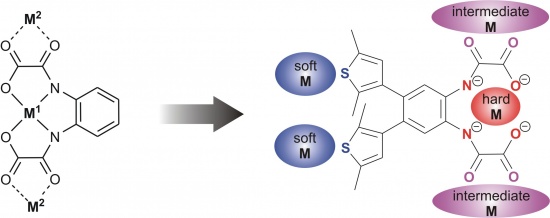Metallosupramolecular Magnetic Networks
o-Phenylene-bisoxamates coordinated by a metal ion M1 at the central position represent versatile building blocks for constructing multidimensional magnetic materials. This is due to the ability of metal bisoxamates to coordinate additional metal ions M2 at the ligand’s periphery producing multimetallic complexes, chain structures, as well as two- and three-dimensional networks of interacting paramagnetic metal ions. Such metallosupramolecular structures find applications as single-molecule magnets, single-chain magnets, and high-dimensional molecule-based magnets. Metal ions M2 coordinated to the periphery of the ligand act as bridges being actively involved into the formation of metallosupramolecular chains and multidimensional networks, whereby the intrinsic magnetic properties of monomeric M2M1M2-bisoxamate units are perturbed.
Alternative approach to create molecular materials with novel and enhanced magnetic properties consists of the controlled synthesis of metallosupramolecular assemblies via a rational ligand design. Targeting the synthesis of multidimensional magnetic materials, our approach to the design of o-phenylene-bisoxamate ligands employs the creation of auxiliary “soft” coordination sites at the phenylene unit, which are not competing with the central “hard” N2O2 and the two side “intermediate” O=C–C=O coordination sites. Appropriate metal ions added to a preformed M2M1M2-bisoxamate and capable to coordinate to auxiliary sites can consequently act as bridges offering a possibility to control the architecture of metallosupramolecular structures.

Publications:
Tetraanionic N2O2-Coordinating Ligands as Potential Building Blocks for Supramolecular Magnetic Networks.
M. Milek, A. Witt, C. Streb, F. W. Heinemann, M. M. Khusniyarov,
Dalton Trans. 2013, 42, 5237–5241. link
